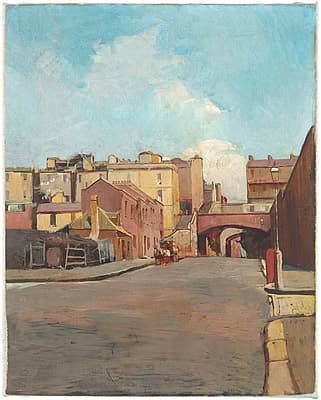
Sydney
LONG
Australia
1871
–
London
1955
England, Europe 1910-21; Australia 1921- 22; England 1922-25; Australia 1925-52; England from 1952
49.0 (h) x 37.5 (w) cm Mitchell Library, State Library of New South Wales ... Mitchell Library, State Library of New South Wales, Sydney, transferred 1920
A panic had set in, and the people from the infected area were hurrying to take advantage of the safeguard [to be inoculated]. Up at the Board of Health the crush was dreadful and the crowd struggled and fought to get in .... [When injected] the men shouted and swore, and … they charged out like mad bulls ... The women … didn’t scream. When it was over they drifted outside wearily, and hung about on one another’s necks, and wept softly … wondering if they were going to die. (Bulletin, 31 March 1900)
Long’s group of Rocks works were produced, as part of a push to commemorate the area which was due for demolition in 1901 as a response to an outbreak of bubonic plague. There was a lack of adequate water and very poor drainage and sewerage facilities in the area, and the streets were unclean. In this painting as in Ferry Lane (cat 16), Long used a light palette with low contrasting colours to convey the stifling heat in the unsanitary streets.
In order to provide direct easy access between Millers Point and Circular Quay, convict labour, using hand tools, began working in 1843 on carving out Argyle Cut. But the project was abandoned due to lack of progress and only restarted again in 1857. This time, paid council labour, using drills and explosives, was able to finish the task by 1859.
The view was a popular one with artists. For instance, Clarence Backhouse, Elliot Johnstone and W.J. Thomas also included paintings of this subject in the Exhibition of pictures of old Sydney 1902. Sydney Ure Smith made an etching of it in 1916 and Lionel Lindsay made etchings of the scene three times from the same approach, between 1910 and 1923, and once from the opposite direction in 1917.
A panic had set in, and the people from the infected area were hurrying to take advantage of the safeguard [to be inoculated]. Up at the Board of Health the crush was dreadful and the crowd struggled and fought to get in .... [When injected] the men shouted and swore, and … they charged out like mad bulls ... The women … didn’t scream. When it was over they drifted outside wearily, and hung about on one another’s necks, and wept softly … wondering if they were going to die. (Bulletin, 31 March 1900)
Long’s group of Rocks works were produced, as part of a push to commemorate the area which was due for demolition in 1901 as a response to an outbreak of bubonic plague. There was a lack of adequate water and very poor drainage and sewerage facilities in the area, and the streets were unclean. In this painting as in Ferry Lane (cat 16), Long used a light palette with low contrasting colours to convey the stifling heat in the unsanitary streets.
In order to provide direct easy access between Millers Point and Circular Quay, convict labour, using hand tools, began working in 1843 on carving out Argyle Cut. But the project was abandoned due to lack of progress and only restarted again in 1857. This time, paid council labour, using drills and explosives, was able to finish the task by 1859.
The view was a popular one with artists. For instance, Clarence Backhouse, Elliot Johnstone and W.J. Thomas also included paintings of this subject in the Exhibition of pictures of old Sydney 1902. Sydney Ure Smith made an etching of it in 1916 and Lionel Lindsay made etchings of the scene three times from the same approach, between 1910 and 1923, and once from the opposite direction in 1917.
A panic had set in, and the people from the infected area were hurrying to take advantage of the safeguard [to be inoculated]. Up at the Board of Health the crush was dreadful and the crowd struggled and fought to get in .... [When injected] the men shouted and swore, and … they charged out like mad bulls ... The women … didn’t scream. When it was over they drifted outside wearily, and hung about on one another’s necks, and wept softly … wondering if they were going to die. (Bulletin, 31 March 1900)
Long’s group of Rocks works were produced, as part of a push to commemorate the area which was due for demolition in 1901 as a response to an outbreak of bubonic plague. There was a lack of adequate water and very poor drainage and sewerage facilities in the area, and the streets were unclean. In this painting as in Ferry Lane (cat 16), Long used a light palette with low contrasting colours to convey the stifling heat in the unsanitary streets.
In order to provide direct easy access between Millers Point and Circular Quay, convict labour, using hand tools, began working in 1843 on carving out Argyle Cut. But the project was abandoned due to lack of progress and only restarted again in 1857. This time, paid council labour, using drills and explosives, was able to finish the task by 1859.
The view was a popular one with artists. For instance, Clarence Backhouse, Elliot Johnstone and W.J. Thomas also included paintings of this subject in the Exhibition of pictures of old Sydney 1902. Sydney Ure Smith made an etching of it in 1916 and Lionel Lindsay made etchings of the scene three times from the same approach, between 1910 and 1923, and once from the opposite direction in 1917.
